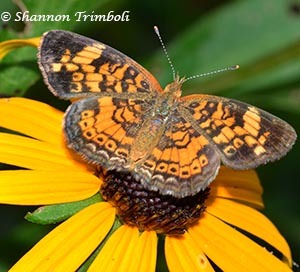
The black-eyed susan (Rudbeckia hirta) is a native wildflower that belongs to a group of flowers called the coneflowers. The coneflowers include popular wildflowers like the black-eyed susans, brown-eyed susans, purple coneflower, grey-headed coneflower, and many others.
Coneflowers are semi-drought tolerant and bloom during the summer. In Kentucky, Black-eyed susans bloom from June to September.
What we think of as an individual black-eyed susan flower is actually a composite of many smaller flowers. The bright yellow petals are sterile ray flowers whose sole purpose is to attract pollinators. The brown center is made up of lots of individual flowers containing nectar and pollen. The brown flowers closest to the yellow ray flowers bloom first and the ones in the very center bloom last.
All coneflowers are important sources of nectar and pollen for many native pollinators. Butterflies are especially attracted to black-eyed susans and other coneflowers because the flowers provide a sturdy platform where the butterfly can land. There are times when almost every black-eyed susan in my garden has at least one butterfly on it.

Native bees also commonly visit black-eyed susans. Some places list black-eyed susans as good for honeybees as well. I think honeybee use of black-eyed susans may depend on location and the availability of other flowers. I rarely see honeybees on my black-eyed susans even though one of my hives is less than 3 feet from a large clump of them.
Black-eyed susans are relatively easy to grow in the garden and often self-seed profusely. The flowers are beneficial for pollinators. Goldfinches and other birds will readily eat the seeds in the fall and winter if you leave the seed heads on the plants. Planting black-eyed susans in clumps not only increases their visual attractiveness, but can also make it easier for pollinators and birds to find them.

This article was part of Shannon’s original Kentucky Pollinators and Backyard Wildlife blog which evolved into the blog for Backyard Ecology.

Backyard Ecology: Exploring Nature in Your Backyard
Nature isn’t just “out there.” It’s all around us, including right outside our doors. Hi, my name is Shannon Trimboli, and I am the host of Backyard Ecology. I live in southcentral Kentucky and am a wildlife biologist, educator, author, beekeeper, and owner of a nursery specializing in plants for pollinators and wildlife conservation. I invite you to join me as we ignite our curiosity and natural wonder, explore our yards and communities, and improve our local pollinator and wildlife habitat. Learn more or subscribe to my email list at www.backyardecology.net.

Leave a Reply